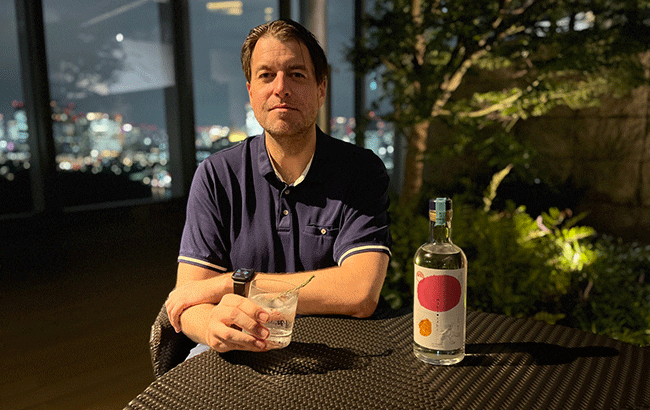SB meets… Thomas Brayman, Nomu-Japan
By Nicola CarruthersThe founder of Nomu-Japan tells us about combining Japanese craft and modern techniques to create Wabi Sabi Gin.

Who is behind Nomu-Japan?
Nomu-Japan began with three of us. Wakae, my wife, inspired the gin project, and she is the brains behind it. Born and bred in Tokyo, she has a natural palate and several wine certifications while her day job is a lawyer. Our friend and partner, Jérôme Quilbeuf, is an internationally award-winning chef from Paris, who helped accelerate the project.
I am the ‘business guy’ for the gin project, a former investment banker and entrepreneur from the US. I was a hobbyist distiller before moving to Tokyo. I hold several wine certifications and distillation qualifications. Nomu means ‘to drink’ in Japanese, so ‘drink Japan’.
What led to Wabi Sabi Gin?
The concept evolved when Wakae and I moved from NYC to Tokyo in 2016. There were only a few Japanese gins we liked. We wanted to create something with distinctive balanced flavours that were bold, elegant and modern, to showcase the best of Japan.
In 2017, I started experimenting with macerating and blending Japanese botanicals with grain neutral spirit to create favourable flavour profiles. I did not have a Japanese distilling licence, so we called my concoction ‘Wabi Sabi Gin’, which loosely translates to ‘beauty in imperfection’. At the time, there were virtually no white labelling opportunities in Japan, which meant there was no chance of really creating the gin we wanted, so we tabled the project.
In the summer of 2020, we sat down with Jérôme at his newly opened restaurant in Tokyo. After a few G&Ts, we reignited the idea, and with Jérôme in tow we decided to go for it. From there, Wakae embarked on a mission to find a Japanese distiller who could help replicate what we wanted and produce at scale. After a year-plus of testing, tasting and iterating, we found our guy, Kaz, a day before Christmas 2021, a wine professional and amazing distiller. How is the gin produced?
We use organic botanicals sourced from an amazing terraced farm that overlooks the sea. Our production blends two slightly different batches together before some ageing and bottling to add depth and complexity to the gin. The distillation process uses a modern, precision pot still. When modern technique meets ancient Japanese practices and craftsmanship, magic happens.
Which markets are you targeting?
Exporting is our primary focus since the Japanese domestic market is small. In Japan, we will distribute to high-end hotels, bars and restaurants. Our initial target export markets for Wabi Sabi Gin are the UK, EU and the US.
What do you have planned for Wabi Sabi Gin in the year ahead?
We launched Wabi Sabi Gin in 2022, and were awarded a grant by the Japanese National Tax Authority to promote the gin internationally. As part of the grant, we are creating a low-calorie, ready-to-drink (RTD) product that uses our gin as the base. In 2023, we are confident we’ll expand our sales and distribution footprint internationally, and launch our RTD.
What opportunities would you like to tap into?
There are excellent craft spirits producers throughout Japan because they are meticulous, exacting and evolving. The biggest challenge for producers are the language barriers, access to outside of the country, and knowledge of international regulations. This forces producers to rely on the Japanese trading houses for exports, which kills their margins. We want to change this cycle by advising domestic craft spirits producers and bringing them to the international markets as partners.
Related news
Empress 1908 Gin goes alcohol free
